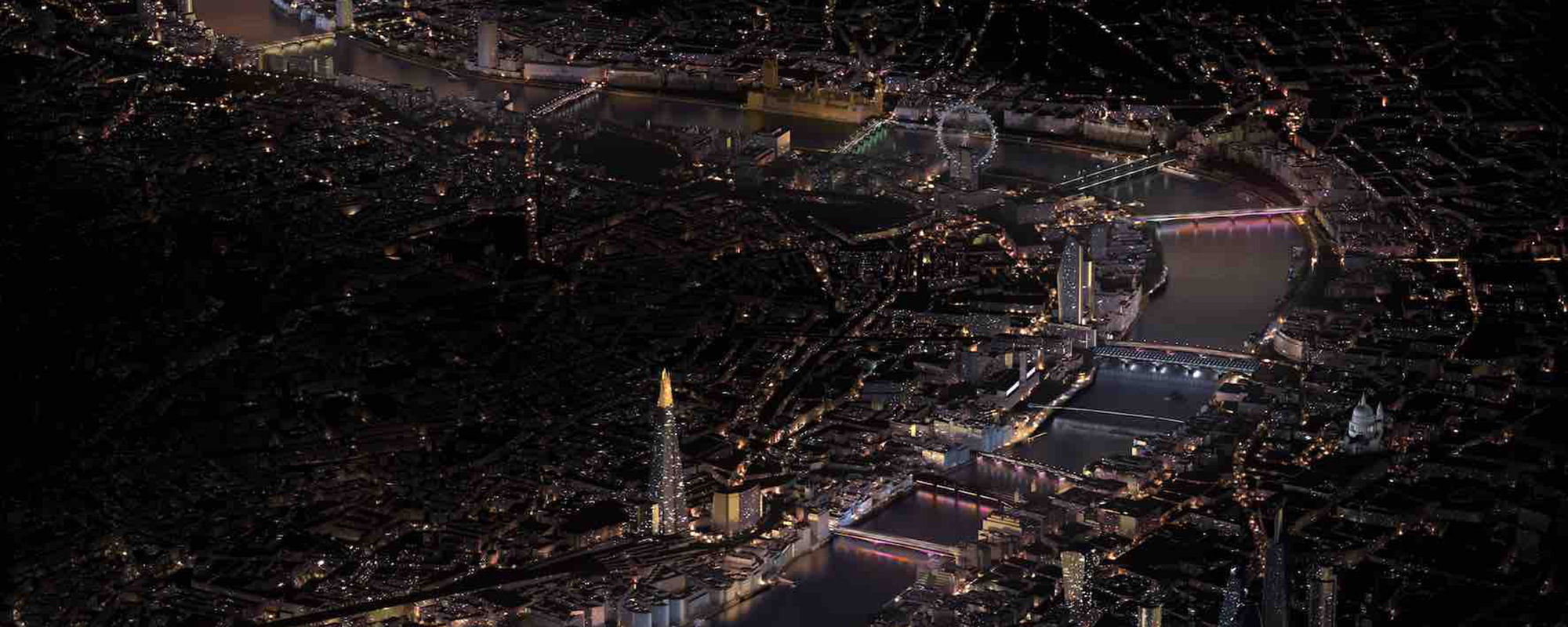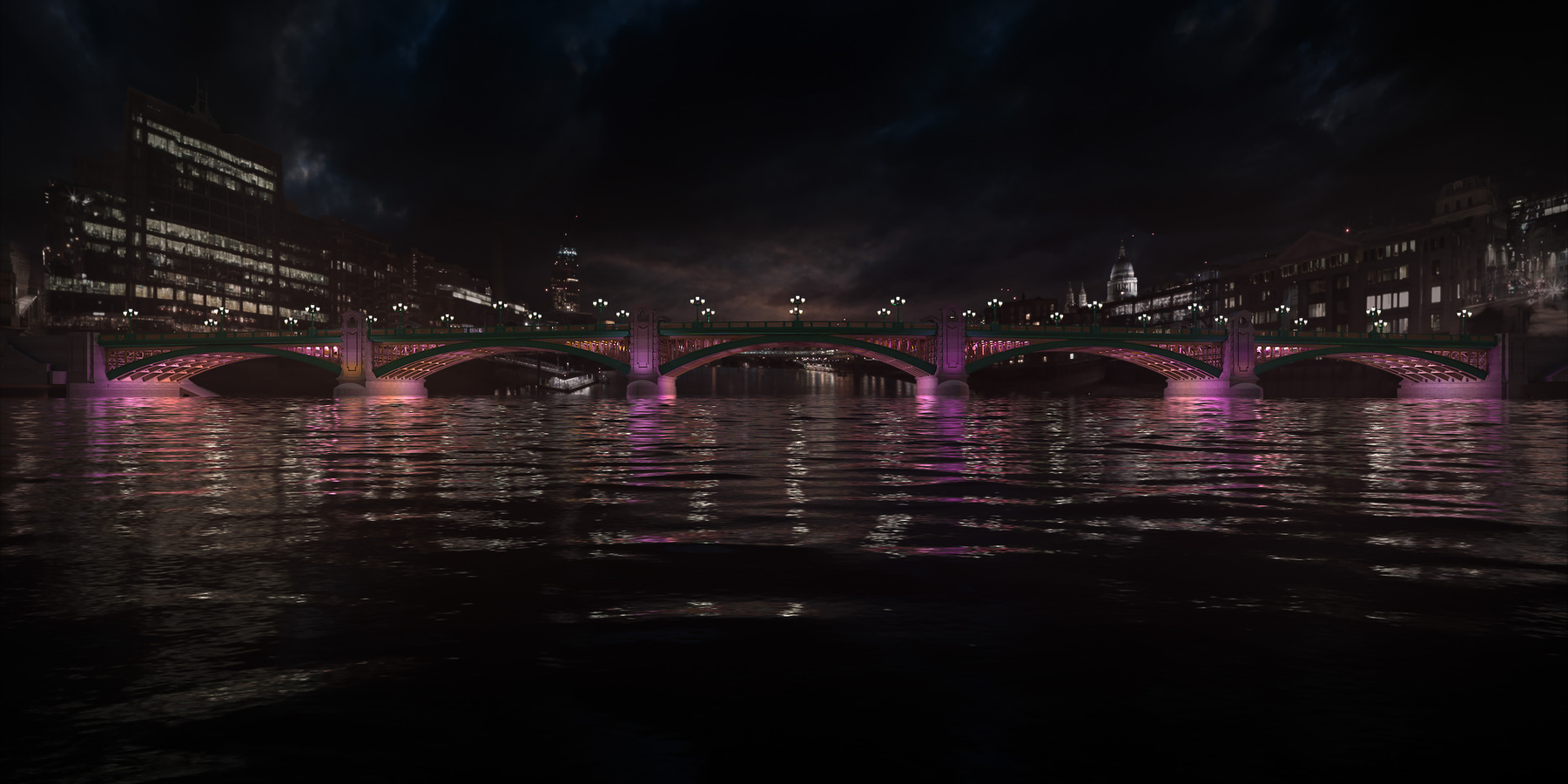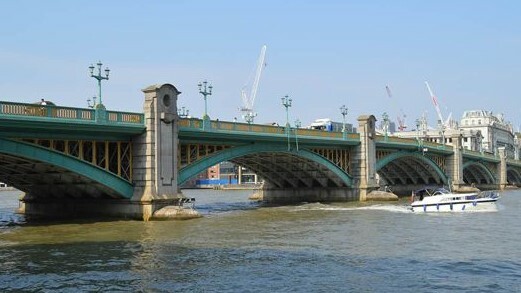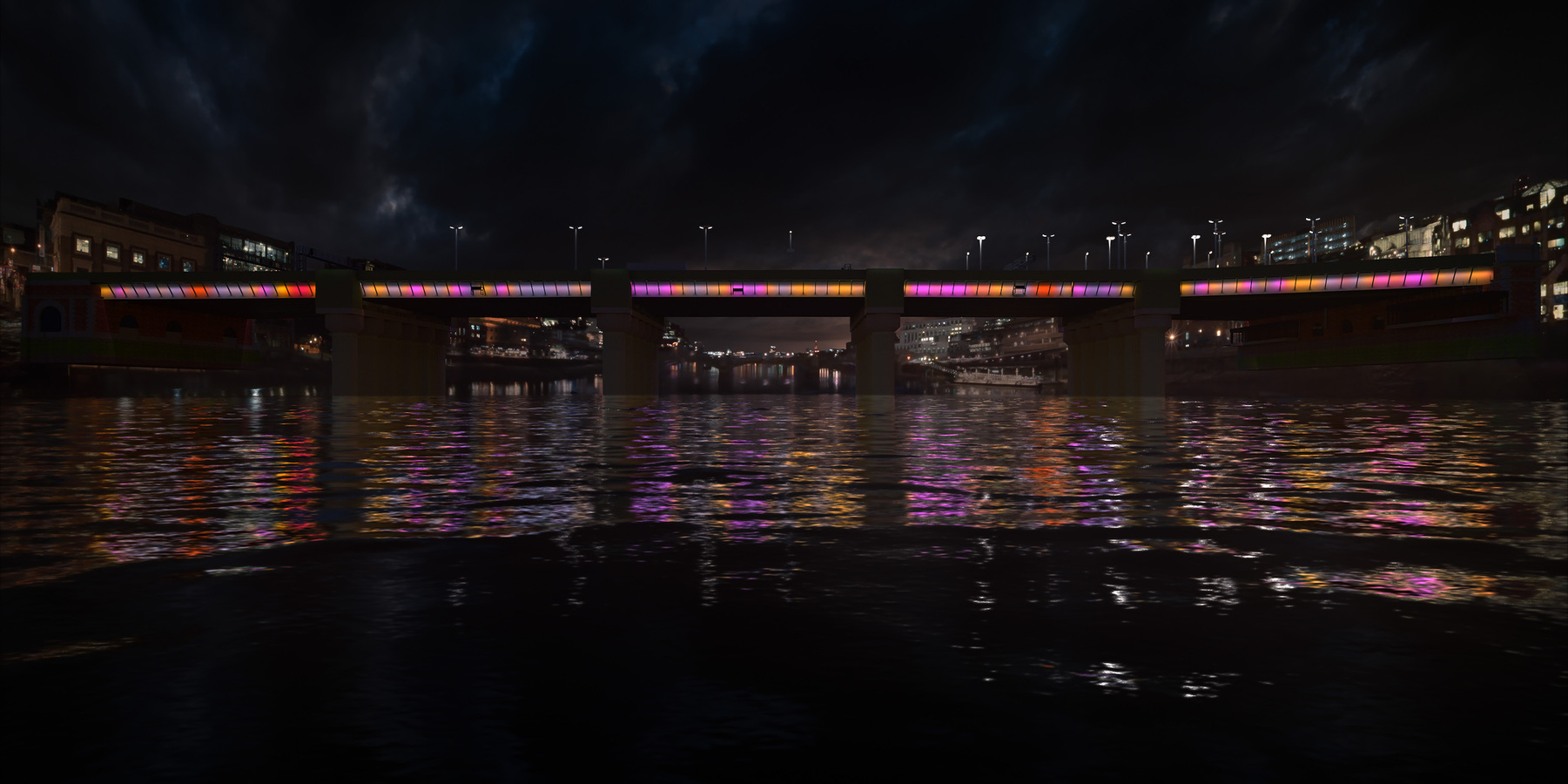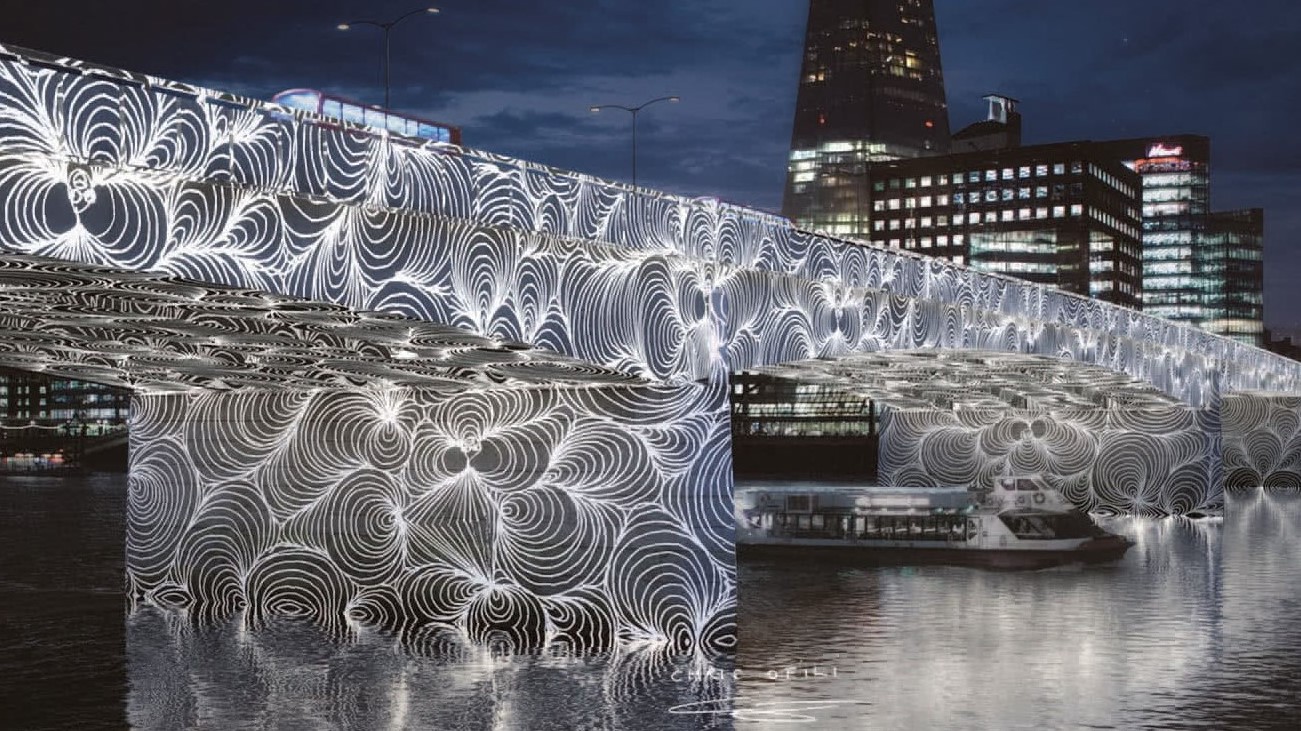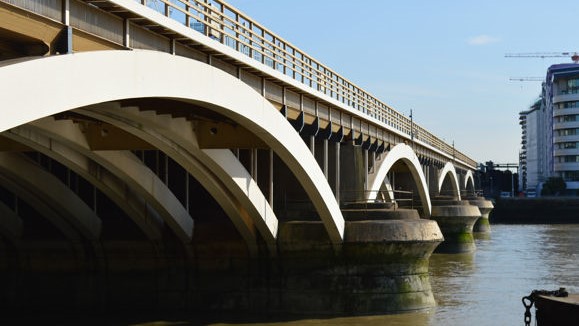Get updates from The Developer straight to your inbox Yes, please!
“London is only here because of the Thames”
Director of the Illuminated River Foundation, Sarah Gaventa discusses Leo Villareal’s public art scheme that will accentuate up to 15 London bridges over the Thames
Launched in 2016, the ambitious £45m Illuminated River project will complete its first phase this year with the lighting of London Bridge, Cannon Street, Southwark and Millennium Bridge, with up to 15 bridges due to be completed by 2022. The LED installation by artist Leo Villareal will be in place for a decade, after which the equipment will be gifted to the bridge owners.
The entire project is funded by philanthropists. Public space expert and director of the Illuminated River Foundation, Sarah Gaventa says she would have refused to be part of Illuminated River otherwise: “These are not the times to be using public money on nice-to-haves.”
There is, however, a contribution from the mayor’s £250,000 Olympics legacy pot, and the City of London gave £500,000 to the lighting of London Bridge. Gaventa says that this money will be from the city’s own maintenance budget because the project is providing free equipment that won’t need replacing.
The idea for Illuminated River was originally that of Lord Rothschild (the Rothschild Foundation is one of the backers, alongside the Blavatnik Family Foundation and Arcadia). Rothschild wanted “to enhance the architectural character” of Waterloo Bridge that he had observed while working in Somerset House.
The mayor felt it was important that the urban scale art engage the public and provide a cultural legacy after the Olympics. “It’s an opportunity to celebrate what is the biggest public space in London, and the architecture and history of the bridges that span it,” Gaventa tells us.
An initial competition attracted over a hundred entries judged by a jury that included James Turrell, Ricky Burdett, Lucy Musgrave, Julia Peyton-Jones and Michael Craig-Martin. Of the shortlisted five projects, AL_A’s proposal highlights the underbellies of the bridges and their elevation in relation to the tide; Adjaye Associates focused on the unique aspects of each individual bridge, assembling an international group of artists.
Leo Villareal’s proposal entitled ‘Current’ came out on top. Villareal is notable for ‘The Bay Lights’, a sight-specific lighting sculpture that adorns the San Francisco-Oakley Bay Bridge. The project is described as a “sensitive, interactive and site-specific interplay with the river”. The visualisations evoke the celestial installations of jury-member Turrell, who has supported Rothschild in the realisation of the project.
Villareal’s work is conceived to be an immediate and accessible dialogue with the history and architecture of the bridges, and the scale of the artwork is unprecedented in London. This places pressure on Gaventa, who knows that they must get it right. “I think when you do something in the centre of the London you’ve got a huge responsibility to join things up… and London is only here because of the Thames,” Gaventa says.
Artists like Turrell and Christo have altered spaces with exciting and vast public sculptures –recently Christo’s Mastaba sculpture in Hyde Park. Illuminated River hopes to achieve the same public spectacle with rippling and beneficial effects on the experience and atmosphere of the Thames.
But Rowan Moore, the architecture critic at The Observer, has questioned the character of the project. He says that there is a ‘hazard’ when handing over the space to an artist because it “risks creating a filter that will narrow and edit all future experiences of the Thames”. This seems a valid criticism because the project says it wants to improve the connectedness of the city, but Villareal is an American artist with no apparent connection to London.
“Probably the worst place you could do a project is on a bridge over a river – logistically it is a nightmare”
Gaventa attributes Villareal’s success “to the concept of creating something that was independent for each bridge but that felt curated and had a nice synergy between them, so it wasn’t 15 disparate artworks but could work together holistically.” She believes that this synergy will do something more for the public realm.
Gaventa was previously director of the government advisory on public space, CABE, and describes how this affects her approach to the Illuminated River project. “I see this not as just an art project but also a public realm project.” She says. “So in terms of creating a better public realm for people. I think bridges are part street, part building, part public space. So you’ve got those issues about how you knit them back into the wider urban fabric”
“The Thames runs at 14mph and has two tides a day. It shouldn’t be taken lightly. The RNLI has its busiest lifeboat station in the entire country by Waterloo Bridge, so you have to treat it with respect as well”
On the Rialto in Venice, or the Charles Bridge in Prague, there are things to stop and see, places to sit, a commercial orientation. The Thames has obstacles in the way of creating lively and public spaces. Gaventa puts it down to safety, ownership and accessibility on the bridges. On Waterloo Bridge, Gaventa says, “It’s so badly lit, at night I wouldn’t go up there, I wouldn’t feel safe.” She believes Illuminated River will create a more successful overall experience. “It would be nice if we could encourage people to stop and linger and have a conversation with someone on the bridge.”
In the wake of the Westminster Bridge attacks, the project will need to make people comfortable and contemplative when they interact with the bridges. Gaventa says they are working with Southwark and the City of London in phase one to see how they can use lights across the river to create a safe environment.
“We’ve walked around the city of London and have actually decided to remove some lights and make a warmer colour temperature that’s more human friendly and less about lighting for traffic,” she says.
Villarreal is working with Lifschutz Davidson Sandilands (LDS), architect of the Jubilee Footbridges and the Royal Victoria Dock Bridge. The actual lighting will be subtle and respond to the environment. London Bridge will have lots of colour. So will Southwark Bridge and Cannon Street because there’s lots of night time activity.
The Millennium Bridge will be lit in white. “That was always an idea by [architect] Norman Foster, to have a blade of light, with a very subtle pulse,” says Gaventa. “In public realm you can’t have disco lights!”
The project will be monitored using an app to track where people are taking photos, to provide a greater understanding of how the spaces are being used. The technical aspects are also being made accessible and simple for maintenance purposes. “There’s no point in creating this thing if it’s too hard to look after,” says Gaventa.
There are many technical difficulties that Gaventa has had to tackle. On Tower Bridge they are looking at magnetic solutions for attaching lighting. While the listed status can prove a problem, Gaventa insists “it’s also the beauty of the bridge”.
“We’ve spent two years trying to make this happen. That includes 30 planning applications, 18 listed building consents. Probably the worst place you could do a project is on a bridge over a river – logistically it is a nightmare.
“We hope that if someone doesn’t have a favourite bridge now, they can have one, and one with the lighting feature on it as well”
“The Thames runs at 14mph and has two tides a day. It shouldn’t be taken lightly. The RNLI [Royal National Lifeboat Institution] has its busiest lifeboat station in the entire country by Waterloo Bridge, so you have to treat it with respect as well.”
The project will inevitably be Instagram-able. Is another tourist magnet a good thing for the Thames’ banks? Gaventa says she’s working on better illuminated routes for locals to benefit from the project. The Southbank is congested with tourists, and Gaventa hopes the project will “spread the Southbank’s concentrated load further towards Southwark”. According to Gaventa, it is about making the river more “permeable”.
Gaventa is particularly excited by the Thames Tideway project, which will clean the river and create new public spaces, including Blackfriars embankment by Hawkins\Brown. Looking towards the Northbank, she says: “At ground level it’s not cultivated; it’s one cafe and mainly lawyers and other offices. They all turn their backs to the river and I think there is a huge opportunity to change that culture.” Gaventa argues that Illuminated River is acting as “a catalyst for more conversations about quality of life in the public realm”.
Gaventa’s ideal result for Illuminated River is to see attitudes towards the Thames changing. She thinks the embankment detaches you from the river, and if you’re closer to the edge there’s a more visceral experience. “We’re trying to make it much more accessible for people to enjoy it. And maybe one day we’ll get a lido, and people might commute along the river more.”
The Garden Bridge designed by Thomas Heatherwick has become a catastrophic blunder in its use of public funds. The project also implied significant construction work that would disrupt the river and the landscape. Gaventa is wary of these pitfalls and is making sure to minimise the detrimental environmental impact of the Illuminated River.
The worry is that light can severely harm natural habitats. Illuminated River has performed a number of surveys to understand the wildlife that occurs on and around the bridges, such as the bats and birds that live in their underbellies. Illuminated River will reduce the light coming from all the bridges by 50% and will use 22,000 connected Philips Color Kinetics LEDs and 13,000 luminaires over the course of the project. These efforts should greatly benefit the wildlife.
Gaventa says they have the wrong name: “We’re not trying to illuminate the river at all, we’re trying to take light off the river”
“The Thames is an amazing wildlife superhighway. There’s over 120 different types of fish in it, but because it’s turbid, you can’t see there’s this life in the water.” Gaventa tells us how the project is working on telling the stories of the Thames wildlife. “We have been talking to the Zoological Society of London about ways of making the invisible visible, without using direct light. For example, the lights might go off on a bridge to indicate there’s spawning going on.”
The project is also engaging with Mud Larks and London Ramblers to make more of those histories and stories. “We hope that if someone doesn’t have a favourite bridge now, they can have one and one with the lighting feature on it as well. And if people want to walk all 15, then that would be brilliant, very good exercise. We’re looking at doing some 5k runs as well.”
With regards to the legacy, Gaventa says they have produced a lot of data which will support the development and protection of the bridges in the future. It cost the project £110,000 to survey all of the bridges, where there was an information gap. “We’ve created these lovely 3D models. All of that information is gifted to the local authorities, the bridge owners, and has been added to the Vu.City model that is used by developers.”
Gaventa is keen to raise the debate on light quality in placemaking, while simultaneously bringing art to the public.
“The light London Bridge throws off is terrible, and Albert Bridge throws out as much light as a motorway,” Gaventa explains.
“One-hundred million people will see this every year, just going about their daily business. This is free and accessible and is art for all. You don’t have to go into a gallery to see it, there’s no closing off of bridges for private parties, there’s no renaming of bridges,” Gaventa says. “It’s purely a philanthropist gesture to London.”
Listen to the podcast by clicking on the link and sign up to The Developer Weekly to be updated when new episodes go online.
Sign up to our newsletter
Get updates from The Developer straight to your inbox
Thanks to our organisation members
Become a member
© Festival of Place - Tweak Ltd., 124 City Road, London, EC1V 2NX. Tel: 020 3326 7238
